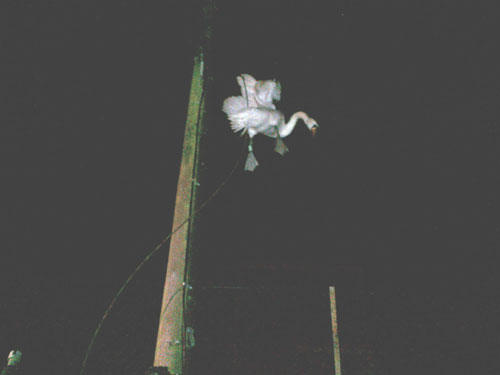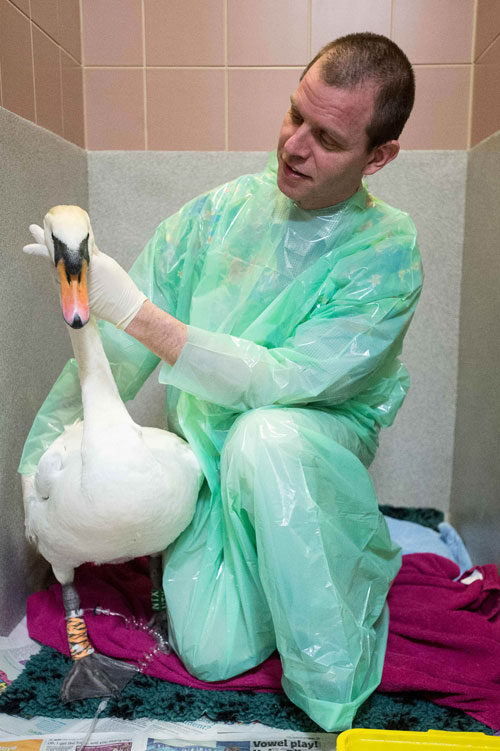THOUSANDS of birds are being slowly poisoned to death because most hunters ignore laws banning lead shot.
Hunters going after pheasant and grouse in wetland areas of Scotland have been banned since 2005 from using lead pellets in shotgun cartridges.
Conservationists say there is irrefutable evidence of swans and many other species suffering high levels of lead poisoning.

Despite that, there have been no reports of any prosecutions for breaking the law.
Concern has also been raised that bird meat contaminated with lead could be making its way into the human food chain.
Wetland species, such as swans, deliberately eat small pieces of grit to assist digestion and occasionally ingest discarded lead shot as a result.
The resulting poisoning is often fatal and the affected bird typically suffers from lack of coordination and balance. A recent spate of swan “crashes” could have been the result of lead poisoning.
Keith Morton, Species Policy Officer at the RSPB, said there had been “huge amounts of resistance” to the new law among hunters.
He added: “People are just ignoring the laws and there is no pro-active enforcement.”
Affected species include many birds that can be legally eaten by humans, including pheasant, partridge, grouse, pigeon, guinea fowl and duck.

Mr Morton added: “The worrying thing is that a huge proportion of meals are prepared from game meat containing high levels of lead – the human health risk is there.
“There has been surprising complacency from the authorities on the risk that lead poses. It’s completely unsatisfactory.”
A recent study found that 34% of over 250 water birds tested at four UK sites had elevated levels of lead in their blood.
Jeff Knott, head of Nature Policy at the RSPB, said: “We need to move to not using lead shot at all – not just in wetland areas..
“There is a big human health concern – standard butchering does not remove all lead which may have got into the animals after being shot.
“Children especially are at risk because they absorb lead much quicker, and it can impact on their brain development.
“There is even a ten-times increased risk of involuntary abortion if pregnant women are exposed to lead in their diet.”

“It’s nasty stuff and is toxic at any level. It’s an invisible killer and something that we are really worried about.
In Scotland, the number of birds that die from lead poisoning has hardly changed since the 1970s.
Professor Kevin Eatwell, an expert in avian medicine the Royal (Dick) School of Veterinary Studies at Edinburgh University, said that lead is causing swans to fly into trees and electricity pylons.

He said: “We have found a high correlation of injured swans have lead in their system. Many end up disorientated and end up flying into trees and pylons and hurting themselves – unfortunately it’s very common to see.”
Dr Colin Sheddon, Scottish Director for the British Association for Shooting and Conservation said: “There are some very sweeping claims being made and shaky assumptions being drawn here.
“The shooting community is extremely law-abiding and is monitored by wardens and the police.
“I am only aware of one conviction being made since 2004, which shows how closely we are following the regulations.
“A lot of these birds are migratory and could easily have ingested the lead before they arrived in Scotland.
“We find it hard to believe that people are disobeying the law. Our community has taken a responsible view on the legislation.
“It’s also not up to wildlife associations to be setting off food scares by saying that lead has made its way into the human food chain. That would be a matter for a food standards agency.”
The Scottish Government denied there was any crisis.
A spokesman said: “Regulations came into force in March 2005, banning the use of lead shot over wetlands in Scotland.
“Enforcement of the ban is a matter for the Police, who have the powers to inspect gun, cartridges and shot game or wildfowl.
“We have no evidence that the ban is being widely ignored, neither have we seen any evidence in Scotland of birds being affected by lead poisoning.”
